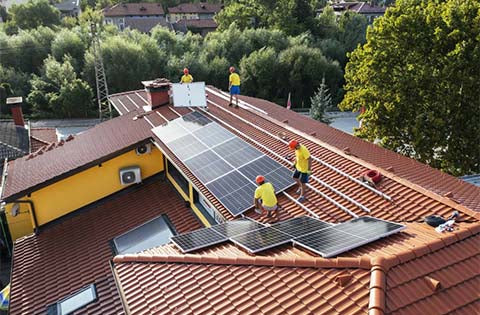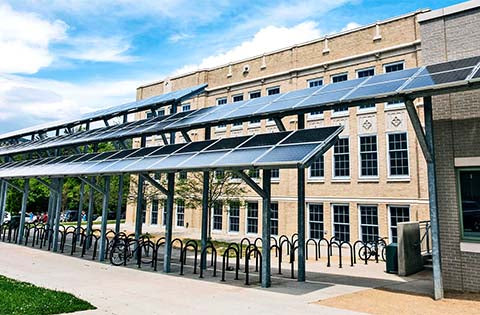With more and more residential homeowners are switching to solar, the rooftop solar system is gradually gaining great popularity. In this article, we summarize five common questions brought by some homeowner. And below are the answers to five of the most common questions about rooftop solar power for home use.
1: Is my roof a good candidate for solar panels?
Most residential customers considering the switch to solar power want to know whether their roof is even fit for solar in the first place. The truth is, solar panels can be installed on almost any type of roof – you just have to find the right mounting system for the job.
The first thing to consider before a roof installation is the material that the roof is composed of. The most common roofing material, composition shingle, is one of the easiest to install solar panels onto aside from a metal roof. In general, solar panels are best installed on a sturdy roof that is made of composition shingle or metal, and things tend to be a bit more difficult on tile roofs – especially those that are so delicate that technicians can’t walk on them, like Spanish tile.
One technique an installer can use with a tile roof is to remove a section of tile and install shingles where the solar panels are going. This makes the solar system appear flush with the roof due to the raised height of the remaining tiles, and you won’t be able to see the shingle roofing underneath the solar panels.
Each type of roof will likely require a different style of mounting hardware, so if you plan on doing your own installation be sure to discuss those details with a solar consultant. For example, a low slope roof can be tricky to install on, and typically requires hiring a roofing company to install flashings. On the other hand, something like a metal roof can be much more straightforward. On certain types of metal roofs, a solar array can be clamped down without penetration, making it 100% leak-free. You might also check out this video about solar panel mounting options or this one below, which details how to mount solar panels to a roof step-by-step.
In addition to materials, customers should also consider the pitch angle of the roof, the size and shape of the roof, how much shading is present, the direction the roof is facing, and of course the age of the roof. All of these elements can affect how much solar energy your system is able to produce. If the system is installed correctly and optimized, it could potentially cover the cost of a new roof in energy savings in as little as 5 years.
2: Do I need a new roof to install solar?
If your roof is in need of any major repairs, you will want to take care of them before you install your rooftop solar system. Solar energy systems have a lifespan of 25 to 35 years and taking a solar system down to replace a roof can be complicated and costly. But generally speaking, this is only an issue for shingle roofs, which have the shortest lifespan. A shingle roof installed in the last 5 years is probably good to go for solar. For a roof that is older than that, consult a roofer to find out whether you need to replace the roof or perform major maintenance before installing solar panels.
3: Do rooftop solar panels damage the roof?
One huge myth about rooftop solar installations is that it will damage the roof. On the contrary, a rooftop solar system can extend the life of a roof by protecting it from the elements. Rooftop solar arrays are mounted slightly higher than the roof so air can circulate under the panels to prevent overheating. That being said, confirm that the technicians installing your rooftop solar system have experience with your particular roofing material and investigate whether the solar installation will void your original roofing warranty. Also, make sure you regularly clean debris like leaves and pine needles out from under the panels.
4: Can I install a rooftop solar system by myself or do I need to hire an expert?
Depending on your skill set, you can install a solar array on your own or partner with a contractor. Some customers handle a majority of the project on their own but hire contractors for some of the work. For example, you might want to pay a roofing company to install the flashings and then you can bolt on the rails and solar panels yourself. Any local roofing company can install flashings, and the company that installed your original roof will be able to verify that it won’t affect the original warranty.
5: Where might I encounter hidden costs that decrease my ROI?
When a customer asks how solar panels will affect their roof, they’re ultimately questioning whether they’re going to be faced with extra costs or headaches down the line. And this much is true – taking down and storing solar panels while replacing a roof can be costly. One important point to make is that most solar systems have the same lifespan as the average roof, so as long as your roof is in good condition when the solar system is installed, you won’t have to take the solar panels down until it’s time to upgrade both the roof and your solar system.
So whether you’re ready to hop on the roof and install your own solar array or want to hire an expert, there are many design elements to consider. Some of the main takeaways are safety, the longevity of the parts used, and code compliance. If you’re ready to explore your options, contact us through the following ways:
Twitter: Solarparts Instagram: Solarparts
Tumblr: Solarparts Pinterest: Solarparts
Facebook: Shenzhen Solarparts Inc
Email address: Philip@isolarparts.com
Homepage: www.isolarparts.com





